Here you can discover the weirdest amphibians in the world. Some of them have unique characteristics, others stand out for their size and certain species possess incredible abilities.
List of weird amphibians
Chinese Giant Salamander
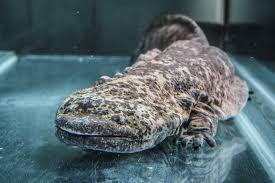
The Chinese giant salamander (Andrias davidianus) is a species that can grow up to 1.8 meters long, making it the largest amphibian in the world.
This amphibian feeds on some aquatic species such as fish, snails, insects, worms, crabs and other amphibians.
The Chinese giant salamander is native, as its name suggests, to that Asian country. These weird amphibians live in cold waters in mountainous areas, especially in the Yellow, Pearl and Yangtze rivers. They take refuge in the waters of deep, dark and cold caves. It is a very difficult species to find, and is threatened by habitat loss due to pollution and illegal poaching.
Axolotl
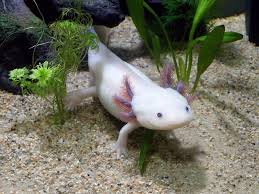
The axolotl (Ambystoma mexicanum) is a species of salamander whose appearance resembles that of a large tadpole.
This weird amphibian generally feeds on worms, slugs, snails, crustaceans, insect larvae, worms, tadpoles and fish.
The salamander is endemic to Mexico, specifically to the canal system of Xochimilco and Chalco. It inhabits fresh waters, and (unlike most salamanders) remains almost all of its life underwater. The Mexican salamander is classified as critically endangered, which means that it is close to disappearing in the wild. The main threat to this animal is habitat loss due to human activity.
Olm
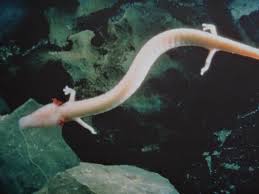
The Olm, proteus, or cave salamander (Proteus anguinus), is a strange amphibian with an elongated (snake-like) body that is completely blind.
The olm is a carnivorous animal whose diet is based mainly on small crustaceans, snails and some insects.
It is one of the weirdest amphibians and is found in Italy, Slovenia, Croatia and Bosnia-Herzegovina. This amphibian is aquatic, and lives in the subway caves of rivers and lakes, in limestone areas. It is a species that is in a vulnerable situation, habitat loss and water pollution are its main threats.
Purple frog
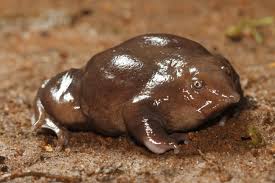
The purple frog or pig-nosed frog (Nasikabatrachus sahyadrensis) is a frog that (unlike most) has a thick, oval body and a narrow, beak-like snout.
The purple frog is an insectivorous amphibian and its diet consists mainly of termites, although it also eats ants.
This frog can be found in India, specifically in the Western Ghats range (although specimens have also been discovered further north). This weird amphibian inhabits forests in mountainous areas, near streams, ponds and creeks. It is a very difficult species to find and is threatened. Its main threat is habitat loss due to deforestation caused by agricultural activity.
Hairy frog
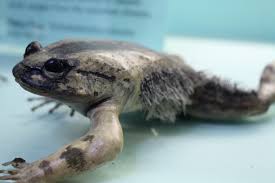
The hairy frog (Trichobatrachus robustus) is a frog noted for the hair-like filaments on the sides and legs of the males.
They are rare, carnivorous amphibians that feed on insects and mollusks, such as beetles, slugs, crickets or spiders.
It is a frog found in Central Africa, and is distributed in Cameroon, Equatorial Guinea, Democratic Republic of Congo, Gabon, Nigeria and Angola. The hairy frog inhabits humid tropical or subtropical forests and near some plantations that require a lot of humidity. Currently, this animal is not endangered; it is considered of least concern. However, its population has declined in recent years due to habitat loss, water pollution and hunting.
Great Crested Newt
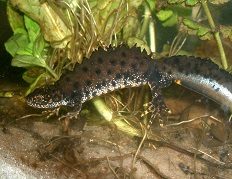
The crested newt, Danube newt or warty newt (Triturus cristatus) is a species of newt that has a crest on its back and a crest on its tail.
The great crested newt is a carnivorous animal and feeds on aquatic and terrestrial invertebrates, such as crustaceans, snails, slugs, worms, insects or spiders, and small amphibians and their larvae.
The great crested newt can be found throughout much of the European continent, especially in central and eastern Europe. These weird amphibians inhabit temperate deciduous and coniferous forests, as well as meadows. They live near quiet water sources, such as ponds and marshes. They are mostly nocturnal animals. To defend themselves from predators, adults produce toxins that are expelled through their skin. The great crested newt population is very abundant and covers many territories, so it is considered a species of least concern.
Darwin’s frog
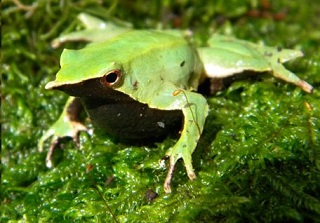
Darwin’s frog, Darwin’s froglet or Darwin’s toad (Rhinoderma darwinii), is an anuran amphibian characterized by its bizarre appearance and the way it cares for its young.
The most distinctive physical feature of this species is its peculiar head; with a triangular, flattened shape and a long, pointed nose.
Darwin’s frog is a carnivorous animal, feeding on insects, larvae, worms, spiders and snails. These weird amphibians (like most frogs) hunt by ambush, as their body shape and color allow them to camouflage themselves successfully in leaf litter.
It is a very rare species and is in danger of extinction. Its greatest threat is the loss of habitat due to deforestation caused by the agricultural industry.
Surinam toad
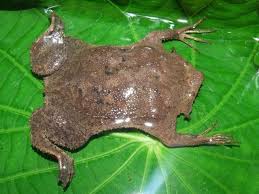
The Surinam toad (Pipa pipa), also known as aparo, cururú or cell frog, is an amphibian characterized by its peculiar flattened shape and its surprising way of reproducing.
It is striking for the shape of its wide and completely flattened body. Like the other species of the Pipidae family, it lacks a tongue. The Surinam toad has dull colors, ranging from dark brown to greenish gray
The most surprising aspect of this animal is its reproduction. The female incubates the eggs on her back, and they remain there until they are fully developed. Three to four months later, the fully developed young break the skin of the mother’s back to emerge and live independently.
The Surinam toad is a carnivorous amphibian that feeds on worms, insects, crustaceans, fish and small amphibians
These weird amphibians can be found in the northern half of South America, from Bolivia to the island of Trinidad. The Surinam toad inhabits tropical and subtropical rainforests, ponds, swamps or slow-flowing streams. Currently this species is not threatened, it is considered of least concern.